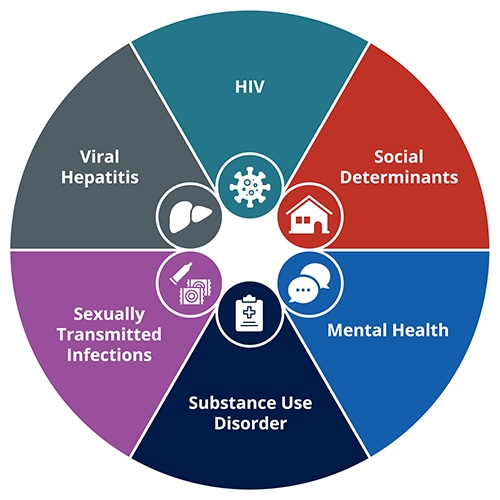Visit the COVID-19 and HIV page for the latest updates on the novel coronavirus outbreak and HIV.

Comprehensive HIV Prevention and Care
Ending the HIV epidemic and advancing health equity require moving beyond traditional models of HIV prevention and care. This means embracing innovative tools and comprehensive whole person approaches to care that also identify and address factors related to inequity and injustice.
Status neutral and syndemic approaches to HIV care recognize broader health and social service needs and integrate these services to help people improve their overall health and quality of life. The Ending the HIV Epidemic in the U.S. (EHE) initiative supports these approaches by delivering solutions designed to equitably reach people where they are with the HIV prevention and care services they need.
Reaching people equitably also means being flexible in how and where healthcare services are delivered (for example, outside of traditional clinical settings) to ensure HIV prevention and care services are accessible to all who could benefit from them. Whole person approaches to HIV care encourage a comprehensive assessment of factors that affect a person’s health and allow for more tailored interventions. As a result, these approaches dismantle structural barriers to accessing care, eliminate stigma, and optimize the health of people with HIV and people who can benefit from prevention services.
Status Neutral Approaches to HIV Care
EHE provides funding to health departments and community-based organizations that can be used to implement status neutral approaches to HIV prevention and care. These approaches improve access to HIV-related services and help people stay engaged in comprehensive and culturally affirming care.
In a status neutral approach to HIV care, people with HIV and people seeking prevention services access HIV care – and other comprehensive health care and services – in the same place. HIV testing serves as an entry point to care regardless of a positive or negative test result. This “one-door” approach puts the needs of each individual ahead of their HIV status by providing or linking to comprehensive and integrated sexual health and other supportive social services as part of ongoing, routine care.

Syndemic Approaches to HIV Care

EHE allows state and local health departments and community-based organizations to adopt and implement syndemic approaches. These approaches integrate a variety of health care, social services, and other community supports to improve health outcomes and quality of life and advance health equity.
Syndemics are a clustering of two or more social or health conditions within a population—such as sexually transmitted infections, viral hepatitis, substance use disorder, and mental health conditions. Social and structural factors create conditions that lead these diseases or health conditions to cluster, or co-occur, within populations. This results in adverse disease interactions and increases the health burden of the population affected.
Syndemics are made worse by social and economic factors, including racism, homophobia, stigma, poverty, and other structural barriers, that contribute to increased prevalence or severity and ongoing health disparities. A syndemic approach to HIV actively works to address the root causes of these conditions.